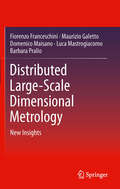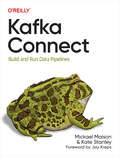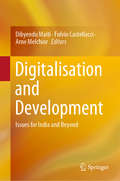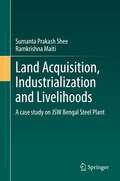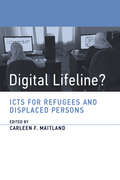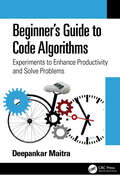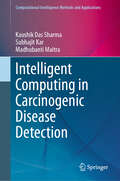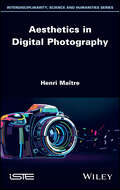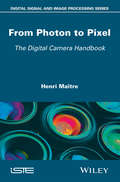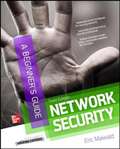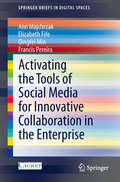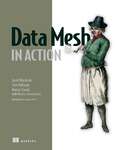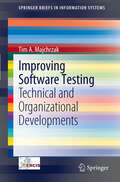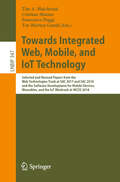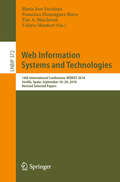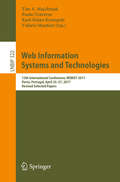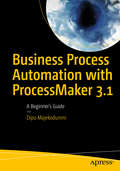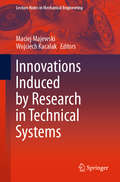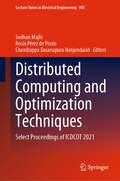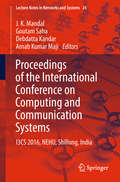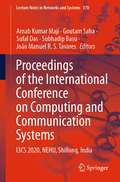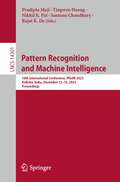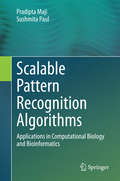- Table View
- List View
Distributed Large-Scale Dimensional Metrology
by Domenico Maisano Fiorenzo Franceschini Luca Mastrogiacomo Barbara Pralio Maurizio GalettoThe field of large-scale dimensional metrology (LSM) deals with objects that have linear dimensions ranging from tens to hundreds of meters. It has recently attracted a great deal of interest in many areas of production, including the automotive, railway, and shipbuilding sectors. Distributed Large-Scale Dimensional Metrology introduces a new paradigm in this field that reverses the classical metrological approach: measuring systems that are portable and can be easily moved around the location of the measured object, which is preferable to moving the object itself. Distributed Large-Scale Dimensional Metrology combines the concepts of distributed systems and large scale metrology at the application level. It focuses on the latest insights and challenges of this new generation of systems from the perspective of the designers and developers. The main topics are: coverage of measuring area,sensors calibration,on-line diagnostics,probe management, andanalysis of metrological performance.The general descriptions of each topic are further enriched by specific examples concerning the use of commercially available systems or the development of new prototypes. This will be particularly useful for professional practitioners such as quality engineers, manufacturing and development engineers, and procurement specialists, but Distributed Large-Scale Dimensional Metrology also has a wealth of information for interested academics.
Kafka Connect
by Mickael Maison Kate StanleyUsed by more than 80% of Fortune 100 companies, Apache Kafka has become the de facto event streaming platform. Kafka Connect is a key component of Kafka that lets you flow data between your existing systems and Kafka to process data in real time.With this practical guide, authors Mickael Maison and Kate Stanley show data engineers, site reliability engineers, and application developers how to build data pipelines between Kafka clusters and a variety of data sources and sinks. Kafka Connect allows you to quickly adopt Kafka by tapping into existing data and enabling many advanced use cases. No matter where you are in your event streaming journey, Kafka Connect is the ideal tool for building a modern data pipeline.Learn Kafka Connect's capabilities, main concepts, and terminologyDesign data and event streaming pipelines that use Kafka ConnectConfigure and operate Kafka Connect environments at scaleDeploy secured and highly available Kafka Connect clustersBuild sink and source connectors and single message transforms and converters
Digitalisation and Development: Issues for India and Beyond
by Dibyendu Maiti Fulvio Castellacci Arne MelchiorThis book investigates the impact of information and communication technologies (ICTs) on development and well-being (beyond economic benefits) and highlights some emerging issues relating to the realities, constraints and digital divides with particular reference to India. It collects a series of novel contributions, studying the Indian experience in an international cross-country perspective. The book also discusses economic, social, and behavioural aspects of well-being as well as access to ICTs across regions, states and individuals to account for the digital divide. The book establishes an aggregate relationship between ICT exposure and well-being at the country level and addresses a number of fundamental issues, such as whether ICT raises the level of transparency and governance. Based on case studies and anecdotal evidence, it then further assesses the effective implementation of service delivery through ICT innovations. The book is divided into four parts: The introductory part surveys the literature and presents background information on the Indian case; introduces the main themes on the relationships between ICT, socio-economic development and digital divides; and provides a summary and roadmap to the chapters of the book. Part II focuses on the impact of ICT on economic performance, including economic growth, productivity and trade. Part III examines the extent of the digital divides in India, including international, regional as well as inter-personal inequality. Finally, Part IV investigates the impact of ICT on governance, users’ well-being and social outcomes. Combining insights from analyses of a variety of socio-economic dimensions related to digitalisation, this book is relevant for a wide range of scholars and researchers across disciplines, as well as practitioners and policy-makers. While the book has a main focus on India, various contributions take an international cross-country comparative perspective, and the results have general relevance for digitalisation and development. On the whole, the main message of this book is that the impact of ICTs is contingent upon other assets, capabilities and institutional conditions. National policies should, therefore, not only promote digitalization as such but also ensure its co-evolution and complementarity with a variety of other country-specific factors. Chapter 'Digitalisation and Development: Issues for India and Beyond' of this book is available open access under a CC BY 4.0 license at link.springer.com
Land Acquisition, Industrialization and Livelihoods: A case study on JSW Bengal Steel Plant
by Ramkrishna Maiti Sumanta Prakash SheeThis book provides an assessment of the impacts of human intervention on the natural environment and peoples' livelihoods through land-use conversion due to industrialization. Problems of land acquisition and the execution thereof have varying consequences that depend on the specific geographical as well as socio-political contexts in which they occur. This book covers a specific study of JSW Bengal Steel Ltd., which in 2014 planned to set up a 10.0 million ton per year integrated steel plant at the upper catchment of Sundra basin, the tributary of the Shilabati that ultimately pours to the river Rupnarayan, located at Salboni Block of Paschim Medinipur, West Bengal, India. The project was ultimately put on hold, but caused many lingering environmental and socioeconomic problems due to the acquisition of formerly productive lands. The book examines this case to generate a database on the different aspects of land acquisition and its negative impacts on the geomorphology and hydrological of non-timber forest products, agricultural impacts resulting in livelihood changes, policy dimensions of land acquisition, and the impacts of delays in project implementation through a comparative analysis between projects-affected areas and non-project areas. The book will appeal to environmental managers and industry workers, as well as students and researchers in environmental economics, anthropology, and human geography.
Digital Lifeline?: ICTs for Refugees and Displaced Persons (Information Policy)
by Carleen F. MaitlandInterdisciplinary perspectives on the role of new information technologies, including mobile phones, wireless networks, and biometric identification, in the global refugee crisis.Today's global refugee crisis has mobilized humanitarian efforts to help those fleeing persecution and armed conflict at all stages of their journey. Aid organizations are increasingly employing new information technologies in their mission, taking advantage of proliferating mobile phones, remote sensors, wireless networks, and biometric identification systems. Digital Lifeline? examines the use of these technological innovations by the humanitarian community, exploring operations and systems that range from forecasting refugee flows to providing cellular and Internet connectivity to displaced persons. The contributors, from disciplines as diverse as international law and computer science, offer a variety of perspectives on forced migration, technical development, and user behavior, drawing on field work in countries including Jordan, Lebanon, Rwanda, Germany, Greece, the United States, and Canada. The chapters consider such topics as the use of information technology in refugee status determination; ethical and legal issues surrounding biometric technologies; information technology within organizational hierarchies; the use of technology by refugees; access issues in refugee camps; the scalability and sustainability of information technology innovations in humanitarian work; geographic information systems and spatial thinking; and the use of “big data” analytic techniques. Finally, the book identifies policy research directions, develops a unified research agenda, and offers practical suggestions for conducting displacement research.ContributorsElizabeth Belding, Karen E. Fisher, Daniel Iland, Lindsey N. Kingston, Carleen F. Maitland, Susan F. Martin, Galya Ben-Arieh Ruffer, Paul Schmitt, Lisa Singh, Brian Tomaszewski, Mariya Zheleva
Beginner's Guide to Code Algorithms: Experiments to Enhance Productivity and Solve Problems
by Deepankar MaitraDo you have creative ideas that you wish you could transform into code?Do you want to boost your problem solving and logic skills?Do you want to enhance your career by adopting an algorithmic mindset?In our increasingly digital world, coding is an essential skill. Communicating an algorithm to a machine to perform a set of tasks is vital. Beginner’s Guide to Code Algorithms: Experiments to Enhance Productivity and Solve Problems written by Deepankar Maitra teaches you how to think like a programmer. The author unravels the secret behind writing code – building a good algorithm. Algorithmic thinking leads to asking the right question and enables a shift from issue resolution to value creation. Having this mindset will make you more marketable to employers. This book takes you on a problem-solving journey to expand your mind and increase your willingness to experiment with code. You will: Learn the art of building an algorithm through hands-on exercises Understand how to develop code for inspiring productivity concepts Build a mentality of developing algorithms to solve problems Develop, test, review, and improve code through guided experimentation This book is designed to develop a culture of logical thinking through intellectual stimulation. It will benefit students and teachers of programming, business professionals, as well as experienced users of Microsoft Excel who wish to become proficient with macros.
Intelligent Computing in Carcinogenic Disease Detection (Computational Intelligence Methods and Applications)
by Madhubanti Maitra Kaushik Das Sharma Subhajit KarThis book draws on a range of intelligent computing methodologies to effectively detect and classify various carcinogenic diseases. These methodologies, which have been developed on a sound foundation of gene-level, cell-level and tissue-level carcinogenic datasets, are discussed in Chapters 1 and 2. Chapters 3, 4 and 5 elaborate on several intelligent gene selection methodologies such as filter methodologies and wrapper methodologies. In addition, various gene selection philosophies for identifying relevant carcinogenic genes are described in detail. In turn, Chapters 6 and 7 tackle the issues of using cell-level and tissue-level datasets to effectively detect carcinogenic diseases. The performance of different intelligent feature selection techniques is evaluated on cell-level and tissue-level datasets to validate their effectiveness in the context of carcinogenic disease detection. In closing, the book presents illustrative case studies that demonstrate the value of intelligent computing strategies.
Aesthetics in Digital Photography
by Henri MaîtreAutomatically evaluating the aesthetic qualities of a photograph is a current challenge for artificial intelligence technologies, yet it is also an opportunity to open up new economic and social possibilities.Aesthetics in Digital Photography presents theories developed over the last 25 centuries by philosophers and art critics, who have sometimes been governed by the objectivity of perception, and other times, of course, by the subjectivity of human judgement. It explores the advances that have been made in neuro-aesthetics and their current limitations.In the field of photography, this book puts aesthetic hypotheses up against experimental verification, and then critically examines attempts to “scientifically” measure this beauty. Special attention is paid to artificial intelligence techniques, taking advantage of machine learning methods and large databases.
From Photon to Pixel
by Henri MaitreThe digital camera conceals remarkable technological innovations that affect the formation of the image, the color representation or automated measurements and settings. ** From photon to pixel photon ** describes the device both from the point of view of the physics of the phenomena involved, as technical components and software it uses. Based on the perceptual properties of the visual system as well as on standard transmission and representation, analyzes the solutions to meet the demands of the photographer on the development, contrast, white balance or stabilization of image. The advanced architectures adopted in mobile phones and developments of computational photography are also presented, foreshadowing the features of the future device.
Network Security: A Beginner's Guide (Third Edition)
by Eric MaiwaldSecurity Smarts for the Self-Guided IT Professional Defend your network against a wide range of existing and emerging threats. Written by a Certified Information Systems Security Professional with more than 20 years of experience in the field, Network Security: A Beginner's Guide, Third Edition is fully updated to include thelatest and most effective security strategies. You'll learn about the four basic types of attacks, how hackers exploit them, and how to implement information security services to protect information and systems. Perimeter, monitoring, and encryption technologies arediscussed in detail. The book explains how to create and deploy an effective security policy, manage and assess risk, and perform audits. Information security best practices and standards, including ISO/IEC 27002, arecovered in this practical resource. Network Security: A Beginner's Guide, ThirdEdition features: Lingo--Common security terms defined so that you're in the know on the job IMHO--Frank and relevant opinions based on theauthor's years of industry experience Budget Note--Tips for getting security technologies and processes into your organization's budget In Actual Practice--Exceptions to the rules of security explained in real-world contexts Your Plan--Customizable checklists you can use on the job now Into Action--Tips on how, why, and when to applynew skills and techniques at work
Get Involved in an E-sports Club! (Join the Club)
by Christina MajaskiExcited about eSports? If so, an eSports club might be the right fit for you! Find out what it takes to join an eSports club or start your own, including information on membership, meetings, and activities. Together, you and your fellow members can participate, create, and most importantly, have fun. Take the plunge, join the club, and get involved!
Activating the Tools of Social Media for Innovative Collaboration in the Enterprise (SpringerBriefs in Digital Spaces)
by Ann Majchrzak Elizabeth Fife Qingfei Min Francis PereiraThe use of social media tools in the enterprise is expanding rapidly and yet, firms are still unclear about the overall value of this activity and how best to facilitate useful outcomes. The focus of this book is, from a managerial standpoint, the control of information, the extent to which such tools can enhance employee satisfaction and how best to use social media tools to attain specific outcomes including innovative collaboration. As companies turn to IT solutions as substitutes for face-to-face engagements, an understanding of the social dynamics - how employees can best communicate, find and use information and generate motivation through computer-mediated activities is fundamental. Lingering questions relate to the strategic use of these tools; many large companies are using Facebook-like applications due to employee demand, but are not studying outcomes comprehensively or managing processes to create desired outcomes. This book fills this knowledge gap through examining the process and results of a controlled study in two companies, one in the US and the other in China. In each company "wiki challenges" were introduced to employees who were provided guidelines to produce goal-oriented outcomes. The book examine the results in each case and suggest guidelines for firms to achieve "wiki-readiness" to support innovation and co-creation.
Data Mesh in Action
by Jacek Majchrzak Sven Balnojan Marian SiwiakRevolutionize the way your organization approaches data with a data mesh! This new decentralized architecture outpaces monolithic lakes and warehouses and can work for a company of any size.In Data Mesh in Action you will learn how to: Implement a data mesh in your organization Turn data into a data product Move from your current data architecture to a data mesh Identify data domains, and decompose an organization into smaller, manageable domains Set up the central governance and local governance levels over data Balance responsibilities between the two levels of governance Establish a platform that allows efficient connection of distributed data products and automated governance Data Mesh in Action reveals how this groundbreaking architecture looks for both small startups and large enterprises. You won&’t need any new technology—this book shows you how to start implementing a data mesh with flexible processes and organizational change. You&’ll explore both an extended case study and multiple real-world examples. As you go, you&’ll be expertly guided through discussions around Socio-Technical Architecture and Domain-Driven Design with the goal of building a sleek data-as-a-product system. Plus, dozens of workshop techniques for both in-person and remote meetings help you onboard colleagues and drive a successful transition. About the technology Business increasingly relies on efficiently storing and accessing large volumes of data. The data mesh is a new way to decentralize data management that radically improves security and discoverability. A well-designed data mesh simplifies self-service data consumption and reduces the bottlenecks created by monolithic data architectures. About the book Data Mesh in Action teaches you pragmatic ways to decentralize your data and organize it into an effective data mesh. You&’ll start by building a minimum viable data product, which you&’ll expand into a self-service data platform, chapter-by-chapter. You&’ll love the book&’s unique &“sliders&” that adjust the mesh to meet your specific needs. You&’ll also learn processes and leadership techniques that will change the way you and your colleagues think about data. What's inside Decompose an organization into manageable domains Turn data into a data product Set up central and local governance levels Build a fit-for-purpose data platform Improve management, initiation, and support techniques About the reader For data professionals. Requires no specific programming stack or data platform. About the author Jacek Majchrzak is a hands-on lead data architect. Dr. Sven Balnojan manages data products and teams. Dr. Marian Siwiak is a data scientist and a management consultant for IT, scientific, and technical projects. Table of Contents PART 1 FOUNDATIONS 1 The what and why of the data mesh 2 Is a data mesh right for you? 3 Kickstart your data mesh MVP in a month PART 2 THE FOUR PRINCIPLES IN PRACTICE 4 Domain ownership 5 Data as a product 6 Federated computational governance 7 The self-serve data platform PART 3 INFRASTRUCTURE AND TECHNICAL ARCHITECTURE 8 Comparing self-serve data platforms 9 Solution architecture design
Improving Software Testing: Technical and Organizational Developments
by Tim A. MajchrzakSoftware is continuously increasing in complexity. Paradigmatic shifts and new development frameworks make it easier to implement software - but not to test it. Software testing remains to be a topic with many open questions with regard to both technical low-level aspects and to the organizational embedding of testing. However, a desired level of software quality cannot be achieved by either choosing a technical procedure or by optimizing testing processes. In fact, it requires a holistic approach.This Brief summarizes the current knowledge of software testing and introduces three current research approaches. The base of knowledge is presented comprehensively in scope but concise in length; thereby the volume can be used as a reference. Research is highlighted from different points of view. Firstly, progress on developing a tool for automated test case generation (TCG) based on a program's structure is introduced. Secondly, results from a project with industry partners on testing best practices are highlighted. Thirdly, embedding testing into e-assessment of programming exercises is described.
Towards Integrated Web, Mobile, and IoT Technology: Selected and Revised Papers from the Web Technologies Track at SAC 2017 and SAC 2018, and the Software Development for Mobile Devices, Wearables, and the IoT Minitrack at HICSS 2018 (Lecture Notes in Business Information Processing #347)
by Tim A. Majchrzak Cristian Mateos Francesco Poggi Tor-Morten GrønliThis book deals with integrated Web, mobile, and IoT technologies. Novel approaches and techniques, new tools and frameworks are needed to address the increasing complexity of the distributed computing paradigms that are coming and the applications therein.This volume contains selected and extended papers from a) the Web Technologies track at the 33rd ACM/SIGAPP Symposium On Applied Computing, b) the Web Technologies track at the 32nd ACM/SIGAPP Symposium On Applied Computing, and c) the Software Development for Mobile Devices, Wearables, and the Internet-of-Things Minitrack at the 51st Hawaii International Conference on System Sciences. Overall, it provides a uniform view of cutting-edge research in Web, mobile and IoT technologies.
Web Information Systems and Technologies: 14th International Conference, WEBIST 2018, Seville, Spain, September 18–20, 2018, Revised Selected Papers (Lecture Notes in Business Information Processing #372)
by Tim A. Majchrzak Valérie Monfort María José Escalona Francisco Domínguez MayoThis book constitutes revised selected papers from the 14th International Conference on Web Information Systems and Technologies, WEBIST 2018, held in Seville, Spain, in September 2018. The purpose of the WEBIST series of conferences is to bring together researches, engineers and practitioners interested in technological advances and business applications of web-based information systems. The 12 full papers presented in this volume were carefully reviewed and selected from originally 68 paper submissions. They cover different aspects of Web information systems, namely internet technology, mobile and NLP information systems, service-based information systems, platforms and eco-systems, Web intelligence and Web interfaces.
Web Information Systems and Technologies: 13th International Conference, WEBIST 2017, Porto, Portugal, April 25–27, 2017, Revised Selected Papers (Lecture Notes in Business Information Processing #322)
by Tim A. Majchrzak Paolo Traverso Karl-Heinz Krempels Valérie MonfortThis book constitutes revised selected papers from the 13th International Conference on Web Information Systems and Technologies, WEBIST 2017, held in Porto, Portugal, in April 2017. The purpose of the WEBIST series of conferences is to bring together researches, engineers and practitioners interested in technological advances and business applications of web-based information systems. The 12 full papers presented in this volume were carefully reviewed and selected from originally 77 paper submissions. They contribute to the understanding of relevant trends of current research on Web information systems and technologies, comprising unified interfaces, Progressive Web Apps (PWAs) as well as a mobile device taxonomy, XML and open data processing, the history of Web engineering, web development for end-users, access control, Web platform assessment, rule engines, and scientific blogging.
Business Process Automation with ProcessMaker 3.1: A Beginner’s Guide
by Dipo MajekodunmiUse this practical, hands-on guide to get started with ProcessMaker. The book provides clear steps for you to walk through and set up ProcessMaker on your own system and make processes run faster and smarter. You will model and build a complete business process for requesting, approving, and reporting expenses. In the course of building the process, you will understand: The Workflow Designer for modeling business processes using BPMN 2. 0 The Dynaform Designer for creating responsive HTML forms Input and Output documents for capturing supporting documents for business processes and generating standardized documents from the data captured in a process Triggers for implementing custom business logic and extending ProcessMaker functionality What You'll Learn Send email notifications and add comments to cases Build complex routing rules Manage users and their permissions Deploy ProcessMaker to a cloud server Configure and use the ProcessMaker mobile app Who This Book Is For Business analysts, programmers, and professionals in all industries (e. g. , higher education, finance and insurance, government, healthcare, manufacturing, and telecommunications)
Innovations Induced by Research in Technical Systems (Lecture Notes in Mechanical Engineering)
by Maciej Majewski Wojciech KacalakThis book reports on innovative technologies and their applications in the field of mechanical engineering, covering new design methods as well as the practical implementation and optimization of existing ones to satisfy growing and changing industrial needs. The book features the proceedings of the International Online Conference on Innovations Induced by Research in Technical Systems (IIRTS’2019), organized by the Department of Technical and Informatics Systems Engineering – Faculty of Mechanical Engineering, Koszalin University of Technology (Poland). The book offers a snapshot of innovative methods, cutting-edge applications, and industrially relevant findings in the broad field of technical systems.
Distributed Computing and Optimization Techniques: Select Proceedings of ICDCOT 2021 (Lecture Notes in Electrical Engineering #903)
by Sudhan Majhi Rocío Pérez de Prado Chandrappa Dasanapura NanjundaiahThis book introduces research presented at the International Conference on Distributed Computing and Optimization Techniques (ICDCOT–2021), a two-day conference, where researchers, engineers, and academicians from all over the world came together to share their experiences and findings on all aspects of distributed computing and its applications in diverse areas. The book includes papers on distributed computing, intelligent system, optimization method, mathematical modeling, fuzzy logic, neural networks, grid computing, load balancing, communication. It will be a valuable resource for students, academics, and practitioners in the industry working on distributed computing.
Proceedings of the International Conference on Computing and Communication Systems: I3cs 2016, Nehu, Shillong, India (Lecture Notes In Networks And Systems #24)
by Arnab Kumar Maji Debdatta Kandar Goutam Saha J. K. MandalThe volume contains latest research work presented at International Conference on Computing and Communication Systems (I3CS 2016) held at North Eastern Hill University (NEHU), Shillong, India. The book presents original research results, new ideas and practical development experiences which concentrate on both theory and practices. It includes papers from all areas of information technology, computer science, electronics and communication engineering written by researchers, scientists, engineers and scholar students and experts from India and abroad.
Proceedings of the International Conference on Computing and Communication Systems: I3CS 2020, NEHU, Shillong, India (Lecture Notes in Networks and Systems #170)
by Arnab Kumar Maji Goutam Saha Sufal Das Subhadip Basu João Manuel R. S. TavaresThis book contains the latest research work presented at the International Conference on Computing and Communication Systems (I3CS 2020) held at North-Eastern Hill University (NEHU), Shillong, India. The book presents original research results, new ideas and practical development experiences which concentrate on both theory and practices. It includes papers from all areas of information technology, computer science, electronics and communication engineering written by researchers, scientists, engineers and scholar students and experts from India and abroad.
Pattern Recognition and Machine Intelligence: 10th International Conference, PReMI 2023, Kolkata, India, December 12–15, 2023, Proceedings (Lecture Notes in Computer Science #14301)
by Pradipta Maji Tingwen Huang Nikhil R. Pal Santanu Chaudhury Rajat K. DeThe LNCS volume constitutes the refereed proceedings of 10th International Conference, PReMI 2023, in Kolkata, India, in December 2023. The 91 full papers, presented together with abstracts of 6 keynote and invited talks, were carefully reviewed and selected from more than 300 submissions. The conference presents topics covering different aspects of pattern recognition and machine intelligence with real life state-of-the-art applications.
Scalable Pattern Recognition Algorithms
by Pradipta Maji Sushmita PaulThis book addresses the need for a unified framework describing how soft computing and machine learning techniques can be judiciously formulated and used in building efficient pattern recognition models. The text reviews both established and cutting-edge research, providing a careful balance of theory, algorithms, and applications, with a particular emphasis given to applications in computational biology and bioinformatics. Features: integrates different soft computing and machine learning methodologies with pattern recognition tasks; discusses in detail the integration of different techniques for handling uncertainties in decision-making and efficiently mining large biological datasets; presents a particular emphasis on real-life applications, such as microarray expression datasets and magnetic resonance images; includes numerous examples and experimental results to support the theoretical concepts described; concludes each chapter with directions for future research and a comprehensive bibliography.
